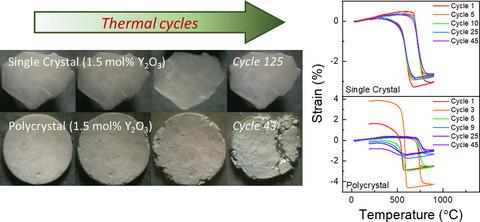当前位置:
X-MOL 学术
›
J. Am. Ceram. Soc.
›
论文详情
Our official English website, www.x-mol.net, welcomes your
feedback! (Note: you will need to create a separate account there.)
Cyclic martensitic transformations and damage evolution in shape memory zirconia: Single crystals vs polycrystals
Journal of the American Ceramic Society ( IF 3.5 ) Pub Date : 2020-03-17 , DOI: 10.1111/jace.17117 Isabel R. Crystal 1 , Alan Lai 1 , Christopher A. Schuh 1
Journal of the American Ceramic Society ( IF 3.5 ) Pub Date : 2020-03-17 , DOI: 10.1111/jace.17117 Isabel R. Crystal 1 , Alan Lai 1 , Christopher A. Schuh 1
Affiliation

|
In zirconia‐based shape memory ceramics (SMCs), cracking during the martensitic transformation can be avoided in structures that reduce the relative presence of grain boundaries where high levels of transformation mismatch stress develop. This approach has been well established in single crystals, but only for sample sizes below about 5 microns. In this paper, we extend the strategy of eliminating grain boundaries to bulk specimen scales by fabricating mm‐scale single crystal SMCs via cold crucible induction melting. For 1.5 and 2.0 mol% Y2O3‐ZrO2, we study the cyclic martensitic transformation of both single crystal and polycrystal structures. Whereas single crystals have very repeatable transformation behavior in terms of hysteresis and strain amplitude, polycrystals degrade dramatically as they accumulate cracking damage with repeated cycling. As the polycrystal evolves from a pellet to granular packing of loose single crystals/grains, the energy dissipation converges with that of the single‐crystal structure, and the energy spent on cracking throughout that process is captured by calorimetry analysis. These results verify that grain boundaries play a key role in damage evolution during martensitic transformation and that microstructural control can extend the size‐scale of viable single crystal or oligocrystal SMCs from the micro‐ to the millimeter scale.
中文翻译:

形状记忆氧化锆中的循环马氏体转变和损伤演化:单晶与多晶
在基于氧化锆的形状记忆陶瓷(SMC)中,可以避免马氏体相变过程中出现裂纹的情况,这种结构可减少出现高水平相变失配应力的晶界的相对存在。这种方法已经在单晶中得到了很好的确立,但仅适用于小于约5微米的样品。在本文中,我们通过通过冷坩埚感应熔化制造毫米级的单晶SMC,将消除晶界的策略扩展到了大块试样。对于1.5和2.0 mol%的Y 2 O 3 -ZrO 2,我们研究了单晶和多晶结构的循环马氏体转变。单晶在磁滞和应变幅度方面具有非常可重复的转变行为,而多晶则随着反复循环而积累开裂损伤,从而急剧降解。随着多晶体从散装的单晶/晶粒的颗粒状发展为颗粒状堆积,能量耗散与单晶结构的能量耗散会聚在一起,并且通过量热分析可以捕获在整个过程中用于裂解的能量。这些结果证明,晶界在马氏体转变过程中的损伤演化中起着关键作用,并且微观结构控制可以将可行的单晶或微晶SMC的尺寸范围从微尺度扩展到毫米尺度。
更新日期:2020-03-17
中文翻译:

形状记忆氧化锆中的循环马氏体转变和损伤演化:单晶与多晶
在基于氧化锆的形状记忆陶瓷(SMC)中,可以避免马氏体相变过程中出现裂纹的情况,这种结构可减少出现高水平相变失配应力的晶界的相对存在。这种方法已经在单晶中得到了很好的确立,但仅适用于小于约5微米的样品。在本文中,我们通过通过冷坩埚感应熔化制造毫米级的单晶SMC,将消除晶界的策略扩展到了大块试样。对于1.5和2.0 mol%的Y 2 O 3 -ZrO 2,我们研究了单晶和多晶结构的循环马氏体转变。单晶在磁滞和应变幅度方面具有非常可重复的转变行为,而多晶则随着反复循环而积累开裂损伤,从而急剧降解。随着多晶体从散装的单晶/晶粒的颗粒状发展为颗粒状堆积,能量耗散与单晶结构的能量耗散会聚在一起,并且通过量热分析可以捕获在整个过程中用于裂解的能量。这些结果证明,晶界在马氏体转变过程中的损伤演化中起着关键作用,并且微观结构控制可以将可行的单晶或微晶SMC的尺寸范围从微尺度扩展到毫米尺度。









































 京公网安备 11010802027423号
京公网安备 11010802027423号